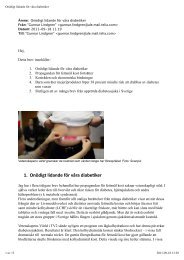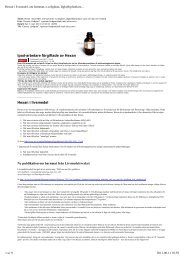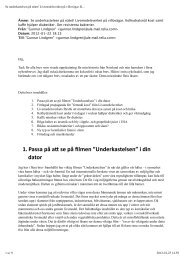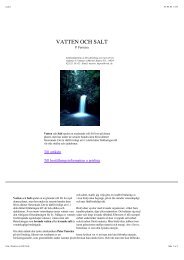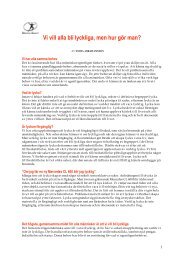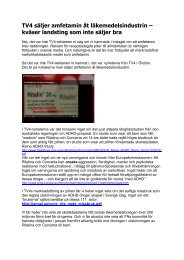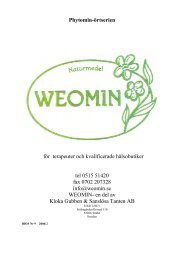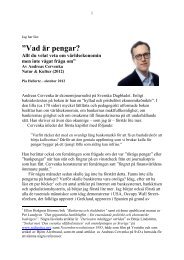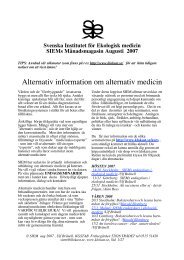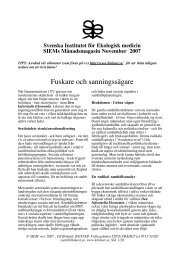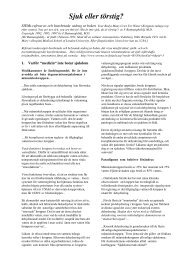Fallet Magnus
Fallet Magnus
Fallet Magnus
You also want an ePaper? Increase the reach of your titles
YUMPU automatically turns print PDFs into web optimized ePapers that Google loves.
Pervasive Developmental Disorders in Preschool Children: Confirmation of High Prevalence<br />
Suniti Chakrabarti, M.D., F.R.C.P.C.H., M.R.C.P., and Eric Fombonne, M.D., F.R.C.Psych.<br />
OBJECTIVE: The rate of reported pervasive developmental disorders has increased, and the authors<br />
found a rate of 62.6 per 10,000 in a previous study of preschoolers in Stafford, U.K. They conducted<br />
another survey in 2002 to estimate the prevalence in children in a later birth cohort and to compare it to<br />
previous findings from the same area.<br />
METHOD: Screening for developmental problems included 10,903 children ages 4.0 to 6.0 years who<br />
were living in a Midlands town on the survey date. Children with symptoms suggestive of pervasive<br />
developmental disorders were intensively assessed by a multidisciplinary team using standardized<br />
diagnostic interviews, psychometric tests, and medical workups.<br />
RESULTS: Sixty-four children (85.9% boys) were diagnosed with pervasive developmental disorders.<br />
The prevalence was 58.7 per 10,000, with a 95% confidence interval (CI) of 45.2–74.9, for all pervasive<br />
developmental disorders, 22.0 per 10,000 (95% CI=14.1–32.7) for autistic disorder, and 36.7 per 10,000<br />
(95% CI=26.2–49.9) for other variants. These rates were not significantly different from the previous<br />
rates. The mean age at diagnosis was 37.8 months, and 53.1% of the children were originally referred by<br />
health visitors. Of the 64 children with pervasive developmental disorders, 29.8% had mental retardation,<br />
but this rate varied by disorder subtype. Few children had associated medical conditions.<br />
CONCLUSIONS: The rate of pervasive developmental disorders is higher than reported 15 years ago.<br />
The rate in this study is comparable to that in previous birth cohorts from the same area and surveyed with<br />
the same methods, suggesting a stable incidence.<br />
Titeln och första meningen talar om en ökning och HÖG incidens<br />
Läkaren som skickade studien skrev: ”Ett vittne som använder studien på det sättet<br />
försöker vilseleda domstolen.”<br />
Som läsarna själva kan se skriver Chakrabarti om en kraftig ökning. Läkaren<br />
som skickade studien till mig skrev att ”ett vittne som använder studien på det<br />
sättet försöker vilseleda domstolen”.<br />
I det sammanhanget kan jag nämna Island igen, där man i en homogen<br />
befolkning, med samma diagnoskriterier, noterar en kraftig ökning.<br />
Fernell påstår att det inte finns några studier som visar att sekretin har någon<br />
effekt.<br />
Double Blind Crossover Study of Secretin/Secrepan Treatment for Children with<br />
Autistic Symptoms<br />
Shin-Siung Jung, Peter Chuan-Hsong Kao1, Yueh-Chieng Lee2<br />
Springtide Foundation of Taiepi City, Taipei, Taiwan; Autism Society of Taiwan1, Taipei, Taiwan; Chin-<br />
Hwa Elementary School of Taipei City2, Taipei, Taiwan<br />
ABSTRACT<br />
Objective: A double blind crossover study of secretin/secrepan treatment for autistic children. Materials<br />
and Methods: Through the encouragement of the autism association, 58 autistic children participated<br />
this study. The children were matched into two teams according to sex, age, body weight, and language<br />
ability, then randomly assigned into experimental and placebo groups. The children in experimental<br />
group received secrepan 50cu intra-muscularly and those in the placebo group received an injection of<br />
normal saline 2 cc. Both were observed for six weeks and then crossovers for the second injection series,<br />
followed by further observation for another sex weeks. Special attention was paid to allergic history and<br />
the management of allergic attack. Wilcoxon- Mann-Whitney and Chi-square tests were used for<br />
analyzing data and comparing both groups, and a Wilcoxon-signed ranks test was used for the pre-test<br />
and post-test analysis. Results: Overall assessment indicated a better efficacy for the experimental<br />
group, than for the controls (p < 0.05 ), in which the sum of a moderate improvement (20%) and a mild<br />
improvement (60%) denotes 80% effectiveness. Active improved symptoms include better language<br />
expression, better sleep pattern, better eye contact, and better socialization activity, which lasted for six<br />
to twelve weeks. Adverse side-effects of secrepan (31% of subjects ) include emotional irritability ,<br />
hyperactivity, and insomnia, although their frequency could not be differentiated from fluctuations in<br />
autistic symptoms. Severe fluctuation of autistic symptoms with weekly worsening and re-improved<br />
rate around 17%-20% was noted. No allergic reaction to the medication was observed in the short<br />
period.Conslusion: Secretin/Secrepan is helpful to autistic children, assisting around 80% with a mild to<br />
moderate improvement . This is still not an overall improvement or a cure for such autistic symptoms,<br />
but it is very helpful for parental management. (Tzu Chi Med J 2000; 12:173-181)<br />
Key words: autism, secretin, secrepan<br />
66



